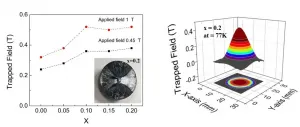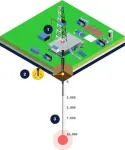On the road to practical, low-cost superconductors with unexplored materials
Researchers from Japan report advantages of high temperature superconductivity in a mixed rare-earth elements systems prepared using trending techniques
2021-06-17
(Press-News.org) Superconductors are something like a miracle in the modern world. Their unique property of zero resistance can revolutionize power transmission and transport (e.g., Maglev train). However, most of the conventional superconductors require cooling down to extremely low temperatures that can only be achieved with liquid helium, a rather expensive coolant. Material scientists are now investigating "high-temperature superconductors" (HTSs) that can be cooled to a superconducting state by using the significantly cheaper liquid nitrogen (which has a remarkably higher temperature than liquid helium).
Currently, a prospective HTS material for such an exploration is (RE)Ba2Cu3Oy, RE-123, where RE stands for "Rare Earth" elements such as yttrium (Y), gadolinium (Gd), erbium (Er), neodymium (Nd), or europium (Eu). These materials in the single-crystalline form are able to overcome physical constraints that weaken superconductivity, thereby opening doors to a variety of engineering applications.
In a recent study published in the Journal of Alloys and Compounds, a team of scientists from Shibaura Institute of Technology, Japan, led by Prof. Muralidhar Miryala, a pioneer in the area of HTS, developed single-crystalline bulk superconductors that can trap magnetic fields within them in a manner similar to how ferromagnets (iron, nickel, cobalt) retain the magnetic field. "The trapped field is one of the most relevant parameters in many practical applications of bulk RE-123 and is related to the bulk diameter," explains Prof. Miryala.
Among the several techniques available for fabricating bulk RE-123, the team went for an infiltrated growth (IG) technique, in which solid (RE)BaCuO5 (RE-211) reacts with a Ba-Cu-O liquid phase to form the superconducting RE-123. Prof. Miryala lays down the motivation behind their approach: "IG technique produces RE-123 bulks without homogeneities, can be performed in air, and scaled up to industrial levels. Moreover, it provides a fertile ground for exploring ternary RE elements systems, which have not been studied until now."
Recently, the team investigated the ternary (Gd0.33Y0.33-xEr0.33+x)-123 bulk system, optimizing its composition by tuning the ratio of Y and Er in the 211 precursor (specifically, x = 0, 0.05, 0.1, 0.15, and 0.2). The team characterized the superconducting phases in the samples using X-ray diffraction and measured the trapped field and superconducting transition temperature (Tc). Finally, they carried out microstructural and chemical analysis using field-emission scanning electron microscope (FESEM) and energy-dispersive X-ray spectroscopy (EDX).
The XRD proved the single-crystalline nature of the RE-123 bulks, with Tc values in the range (91.5-92) K, which were significantly above the boiling point of liquid nitrogen (77K), and the highest trapped field of 0.53 tesla was observed in (Gd0.33Y0.13Er0.53)-123 (x=0.2). FESEM and EDX identified finely dispersed (Gd, Y, Er) -211 particles in all samples, with an Er-rich precipitates distribution for x=0.2, the sample which also showed the best superconducting performance.
"The findings in our study provides a notion of how to implement a low-cost production of high-performance (Gd, Y, Er)BCO bulks for real-life applications such as magnetic levitation, superconducting bearing, flywheel energy storage, magnetic resonance imaging, rotary motors, drug delivery, and water purification," comments a contemplative Prof. Miryala.
Looks like a superconducting future may not be too far!
INFORMATION:
Reference
Title of original paper: (Gd,Y,Er)Ba2Cu3Oy bulk superconducting system processed via infiltration growth
Journal: Journal of Alloys and Compounds
DOI: https://doi.org/10.1016/j.jallcom.2021.160535
About Shibaura Institute of Technology (SIT), Japan
Shibaura Institute of Technology (SIT) is a private university with campuses in Tokyo and Saitama. Since the establishment of its predecessor, Tokyo Higher School of Industry and Commerce, in 1927, it has maintained "learning through practice" as its philosophy in the education of engineers. SIT was the only private science and engineering university selected for the Top Global University Project sponsored by the Ministry of Education, Culture, Sports, Science and Technology and will receive support from the ministry for 10 years starting from the 2014 academic year. Its motto, "Nurturing engineers who learn from society and contribute to society," reflects its mission of fostering scientists and engineers who can contribute to the sustainable growth of the world by exposing their over 8,000 students to culturally diverse environments, where they learn to cope, collaborate, and relate with fellow students from around the world.
Website: https://www.shibaura-it.ac.jp/en/
About Professor Muralidhar Miryala from SIT, Japan
Dr. Muralidhar Miryala is a Professor at the Graduate School of Science and Engineering and Board of Councilor at Shibaura Institute of Technology (SIT), Japan. He is an active researcher in solid state physics and material science with a focus on high temperature superconductivity. His interest is in the applications and technology of bulk single-grain superconductors, RE-123 type silver-sheathed wire, DC superconducting cable, eTc. He has published over 500 research items including patents, books, review-articles, and articles. He has received several awards for his research contributions including the prestigious 2021 Pravasi Bharatiya Samman Award from the Government of India.
Funding Information
The study was funded by Shibaura Institute of Technology (SIT) Research Centre for Green Innovation and Grant-in-Aid FD research budget code: 112282.
[Attachments] See images for this press release:

ELSE PRESS RELEASES FROM THIS DATE:
2021-06-17
TROY, N.Y. -- Optoelectronic materials that are capable of converting the energy of light into electricity, and electricity into light, have promising applications as light-emitting, energy-harvesting, and sensing technologies. However, devices made of these materials are often plagued by inefficiency, losing significant useful energy as heat. To break the current limits of efficiency, new principles of light-electricity conversion are needed.
For instance, many materials that exhibit efficient optoelectronic properties are constrained by inversion symmetry, a physical property that limits engineers' control of electrons in the material and their options for designing novel or efficient devices. In research published today in Nature ...
2021-06-17
With sorghum poised to become an important crop grown by Pennsylvania farmers, Penn State researchers, in a new study, tested more than 150 germplasm lines of the plant for resistance to a fungus likely to hamper its production.
Sorghum, a close relative to corn, is valuable for yielding human food, animal feed and biofuels. Perhaps its most notable attribute is that the grain it produces is gluten free. Drought resistant and needing a smaller amount of nutrients than corn to thrive, sorghum seems to be a crop that would do well in the Keystone State's ...
2021-06-17
The article 'The RNA Atlas expands the catalog of human non-coding RNAs', published today in Nature Biotechnology, is the result of more than five years of hard work to further unravel the complexity of the human transcriptome. Never before such a comprehensive effort was undertaken to characterize all RNA-molecules in human cells and tissues.
RNAs in all shapes and sizes
Our transcriptome is - analogous to our genome - the sum of all RNA molecules that are transcribed from the DNA strands that make up our genome. However, there's no 1-on-1 relationship with the latter. Firstly, each cell and tissue hasve a unique transcriptomes, with varying RNA production and compositions, including tissue-specific RNAs. Secondly, ...
2021-06-17
Additive manufacturing offers an unprecedented level of design flexibility and expanded functionality, but the quality and process can drastically differ across production machines, according to Hui Yang, a professor of industrial engineering at Penn State. With applications in aerospace, health care and automotive industries with potential for mass customization, additive manufacturing needs quality management.
To address this concern, Yang and a team of researchers from Penn State, University of Nebraska--Lincoln and the National Institute of Standards and Technology (NIST) proposed the design, development and implementation of a new data-driven methodology for quality control in additive manufacturing. They published their work in the Proceedings ...
2021-06-17
CAMBRIDGE, MA--Geothermal energy systems have the potential to power the world and become the leading technology for reducing greenhouse gas emissions if we can drill down far enough into the Earth to access the conditions necessary for economic viability and release the heat beneath our feet. END ...
2021-06-17
SAN ANTONIO (June 17, 2021) -- Convalescent plasma therapy was associated with better survival in blood cancer patients hospitalized with COVID-19, especially in sicker patients. The findings by the COVID-19 and Cancer Consortium (CCC19) are newly published in the peer-reviewed journal JAMA Oncology.
The Mays Cancer Center, home to UT Health San Antonio MD Anderson, is part of the CCC19. The international consortium is composed of 124 medical centers and institutions in North and South America that conduct research to learn how COVID-19 affects cancer patients.
Dimpy Shah, MD, PhD, is an epidemiologist and assistant professor of population health sciences at The University of Texas Health ...
2021-06-17
Forest fires have crept higher up mountains over the past few decades, scorching areas previously too wet to burn, according to researchers from McGill University. As wildfires advance uphill, a staggering 11% of all Western U.S. forests are now at risk.
"Climate change and drought conditions in the West are drying out high-elevation forests, making them particularly susceptible to blazes," says lead author Mohammad Reza Alizadeh, a PhD student at McGill University under the supervision of Professor Jan Adamowski. "This creates new dangers for mountain communities, with impacts on downstream water supplies and the plants and wildlife that call these forests home."
Climate warming has diminished 'flammability barrier'
In ...
2021-06-17
If the genome is the recipe of life, base pairs are the individual ingredients listed. These chemical structures form DNA, and every living organism on Earth has just four. The specific arrangements of these four base pairs -- A, T, C, G -- make us who and what we are.
So it was a big surprise when Scripps Research scientists revealed in 2014 that they could introduce two new, unnatural base pairs (they called them X and Y for short) into the genetic code of living bacteria in the lab. It was like two never-seen-before ingredients tossed into the recipe, hypothetically expanding the variety of dishes a cell can whip up.
Researchers immediately saw the potential applications: With more control and selection, they ...
2021-06-17
In a bid to find or refine laboratory research models for cancer that better compare with what happens in living people, Johns Hopkins Medicine scientists report they have developed a new computer-based technique showing that human cancer cells grown in culture dishes are the least genetically similar to their human sources.
The finding, they say, should help focus more resources on cancer research models such as genetically engineered mice and 3D balls of human tissue known as "tumoroids" to better evaluate human cancer biology and treatments, and the genetic errors ...
2021-06-17
An algorithm designed by researchers from Carnegie Mellon University's Computational Biology Department and St. Petersburg State University in Russia could help scientists identify unknown molecules. The algorithm, called MolDiscovery, uses mass spectrometry data from molecules to predict the identity of unknown substances, telling scientists early in their research whether they have stumbled on something new or merely rediscovered something already known.
This development could save time and money in the search for new naturally occurring products that could be used in medicine.
"Scientists waste a lot of time isolating molecules that are already known, essentially rediscovering penicillin," said Hosein Mohimani, an assistant ...
LAST 30 PRESS RELEASES:
[Press-News.org] On the road to practical, low-cost superconductors with unexplored materials
Researchers from Japan report advantages of high temperature superconductivity in a mixed rare-earth elements systems prepared using trending techniques


